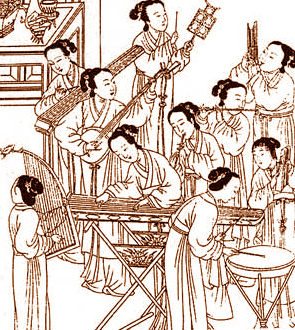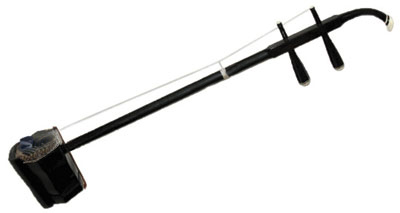

China encompasses a vast territory: approximately 3.7 million square miles. Although there are many ethnic groups in China (at least 55 minority nationalities), approximately 94% of the nation's estimated 1.39 billion population are Han Chinese. For this reason, when music scholars refer to Chinese music, it is often the music of the Han Chinese that they are referring to. Even within the Han Chinese, there are many cultural differences due to factors such as geography, historical events, and different dialects. The Chinese term weidao (meaning "flavor") describes these distinctions between regional styles and musical customs, and refers to a performer who sings or plays well in the "flavor" of a regional style. [42] [43] [44]
China has a rich heritage of art music and folk music traditions. Some scholars of Chinese music have divided the music into the following genres: court music, religious and ritual music, music of the literati, and folk (minjian) music. As a broad category, folk music is used to describe songs associated with work and physical labor, and music for weddings, funerals, festivals and entertainment (including instrumental music, song and dance music, and theatrical music). [45] [46] It should be noted that some music scholars feel that many Chinese folk traditions are as highly developed as classical art music, and therefore could be described as "folk-classical" traditions. [47]
The music scholar Alan Thrasher referred to the influence the Chinese government has played in the development of Chinese music:
Traditionally, music in general was viewed by Chinese scholar-officials as an extension of government theory, and was therefore assigned a very large role in promoting government-sanctioned ideologies. Conformity, social harmony, and respect were highly-stressed values in all aspects of traditional culture, and music and the arts were expected to reflect these qualities. In terms of melodic style the use of anhemitonic pentatonic modal structures (with minimal intervallic tensions), relatively even beat subdivisions (eight- and sixteenth-note rhythms), related (rather than contrasted) thematic material, and group-oriented heterophonic performance all reinforce this sense of social harmony. Collective expression of a community, rather than individual achievement over others, is the dominant social orientation in Chinese creativity. [48]

Some of the main elements of Han music theory include notes (sheng), temperament and pitch (lü), scale (diao), melody (qiang), meter and rhythm (pai), and modal structure (diaoshi). The term mode refers to notes arranged in a specific scale or pattern of intervals, and modes are often used to structure the melody or tonality of a piece. The modal or basic tonal system used in Chinese music is often described as having a pentatonic structure (pentatonic comes from the Greek word pente, meaning five, and is often used to describe music using a five-tone pentatonic scale). The Gong Mode is an example of a pentatonic mode used in Chinese music. The name of this mode, Gong, refers to both the name of the pitch and the pentatonic mode built upon it. It should be noted that all Chinese music is not built upon the same pentatonic mode. Although a large portion of Chinese music, including folk songs, are based upon pentatonic modes, more than one version of a five-tone pentatonic scale is used, and other scales are sometimes used (e.g. seven-tone scales, and occasionally four, six and eight-tone scales). Melodies are often embellished with ornamentation and variations, and the concept of jia hua (meaning "add flowers") describes this concept of embellishment. [49] [50]
Rhythm in Chinese music is often described in terms of strong and weak beats (respectively, ban and yan). These beats are typically combined in groups of two or four beats (comparable to the Western concept of duple meter in 2/4 or 4/4). Triple and compound meters are not commonly used. Some of the techniques used to create form in Chinese music include repetition, elaboration and extended forms. One of the most common ways to create extended form in Chinese music is a suite (called paitao), where melodies are added one after another to create a long composition. [51]
Hundreds of folk instruments are used in China, and some of these are categorized as bowed lutes: stringed instruments, played with a bow. In China, a two-stringed bowed instrument called the erhu is sometimes called the "Chinese violin," "southern fiddle," or "spike fiddle." Chinese scholars have different theories regarding the erhu's origin, and early versions of the erhu (such as the huqin), have been documented in China as far back as the Tang Dynasty (A.D. 618-907). The erhu is a popular folk instrument in China today, and as the illustration in figure 6.2 shows, it is made of wooden soundbox with a long wooden neck (the front of the soundbox is usually covered with snakeskin). Two metal strings extend from the bottom of the instrument to the top of the neck, and the pitch of the strings can be adjusted with tuning pegs. The two strings are generally tuned to the notes D and A (comparable to the open D and A used by the Western violin).

The erhu bow is generally made of bamboo wood, and the bow hair is usually made of horse hair. It is held upright to play (vertically), and a bow is pulled across the strings to produce a sound. The erhu is used to accompany singers or is part of folk ensembles such as the Silk and Bamboo, Jiangnan Sizhu chamber ensemble, and in more recent years, the erhu has been used as a solo instrument. [52] [53]
Some erhu performers have adopted western violin performance techniques. Musicians such Liu Tianhua (1895-1932), a trained western violinist, introduced new erhu fingering, shifting and bowing techniques, and helped extend the conventional range of the erhu to three octaves (traditionally, the erhu's pitch range was one-and-a-half octaves). Western instrumental techniques such as vibrato, glissando, appoggiaturas and shifting are now commonly used by erhu performers, and modern professional erhu players have reached a high level of virtuosity on their instrument. Today, the erhu is used to perform both Chinese art music and folk music. [54] [55] [56]
© Copyright 2025 RK Deverich. All rights reserved.
Although this online violin class is provided free of charge, all rights are reserved and this content is protected by international copyright law. It is illegal to copy, post or publish this content in any form, and displaying any of this material on other websites, blogs or feeds is prohibited. Permission is given for individual users to print pages and perform music from this website for their personal, noncommercial use.